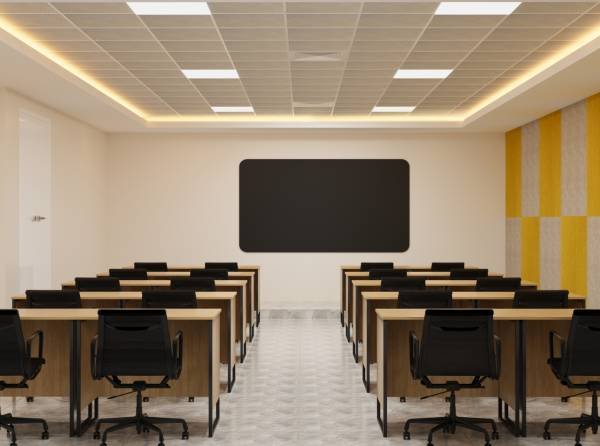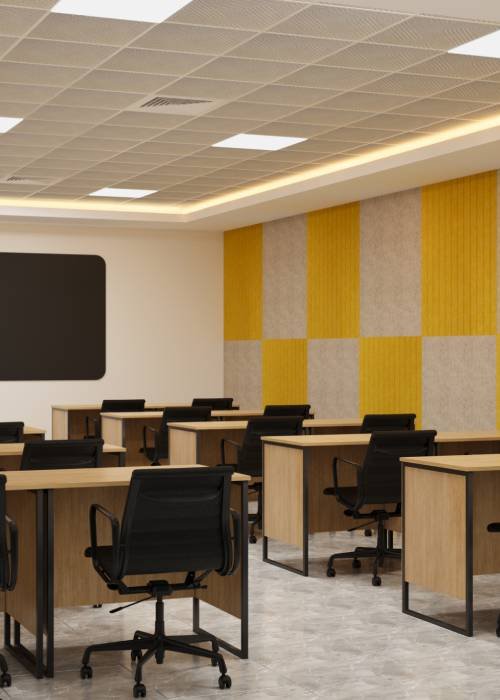Acoustic boards help lessen undesirable reflected sound in any room...
When choosing the raw material for a fake ceiling, you can pick between gypsum boards and POP (plaster of Paris). Both are made up mostly of gypsum, which is a naturally occurring mineral. Gypsum board is made at a factory using gypsum, water, and a few additives sandwiched between two sheets of paper. When gypsum is heated to semi-dehydrate it, it becomes plaster of paris, or POP, a fine white powder with various applications, including the construction of temporary artificial ceilings. Gypsum and POP have several characteristics, such as being lightweight, heat-insulating, and fire-resistant. False ceilings made of these materials, on the other hand, have their own set of benefits and weaknesses. If you’re thinking of installing a new fake ceiling in your house, here are some advantages and drawbacks to consider.


Gypsum boards or panels are prefabricated and ready to use. They are fastened to a metal frame that is affixed to the ceiling slab or soffit using screws (the underside of a structure). Choose only rust-proof, high-quality metal frames for long-term durability.
Advantages: The main advantage of a gypsum ceiling is that it is a rapid and clean installation process that produces less dust.
Because gypsum plaster boards are so big, just a few joints are produced during installation. These joints are completed with a fast-drying jointing compound.Because of their smooth factory finish, gypsum boards are simple to deal with and paint.
Because the combination is created with precision in a factory setting, the quality of good-brand boards remains consistent.
Disadvantages: If the ceiling has to be repaired, it must be dismantled.With time, the gypsum board joints may exhibit signs of cracking. The slightest movement in the fake ceiling owing to ceiling repair, cutting holes for light or fan fittings, or where the ceiling meets the neighbouring walls can also produce cracks.
Moisture seeping into the gypsum ceiling from leaking roofs or air conditioning drain pipes can lead to fungal growth and warping. As a precaution, only use reputable gypsum board brands like India Gypsum, which allow for less water retention.
Gypsum boards or panels are prefabricated and ready to use. They are fastened to a metal frame that is affixed to the ceiling slab or soffit using screws (the underside of a structure). Choose only rust-proof, high-quality metal frames for long-term durability.
Advantages: The main advantage of a gypsum ceiling is that it is a rapid and clean installation process that produces less dust.
Because gypsum plaster boards are so big, just a few joints are produced during installation. These joints are completed with a fast-drying jointing compound.Because of their smooth factory finish, gypsum boards are simple to deal with and paint.
Because the combination is created with precision in a factory setting, the quality of good-brand boards remains consistent.
Disadvantages: If the ceiling has to be repaired, it must be dismantled.With time, the gypsum board joints may exhibit signs of cracking. The slightest movement in the fake ceiling owing to ceiling repair, cutting holes for light or fan fittings, or where the ceiling meets the neighbouring walls can also produce cracks.
Moisture seeping into the gypsum ceiling from leaking roofs or air conditioning drain pipes can lead to fungal growth and warping. As a precaution, only use reputable gypsum board brands like India Gypsum, which allow for less water retention.
Acoustic boards help lessen undesirable reflected sound in any room...
Acoustic boards help lessen undesirable reflected sound in any room...
Open spaces have been known as the trending layout for...
WhatsApp us